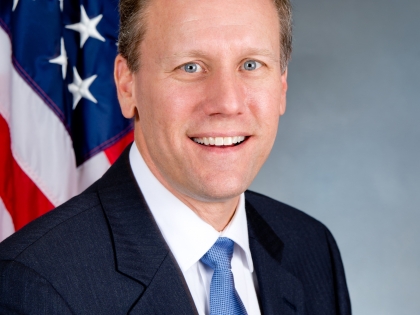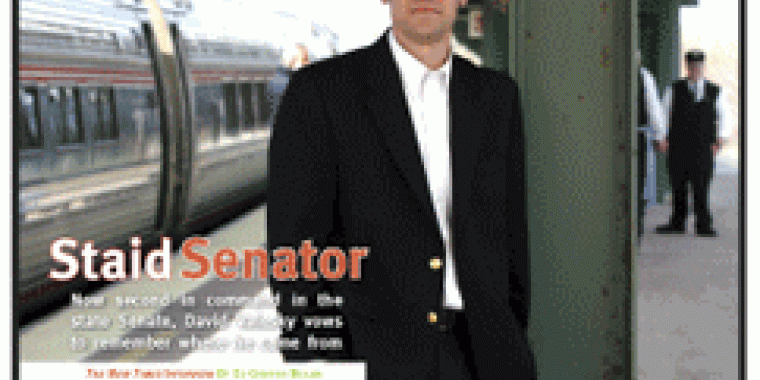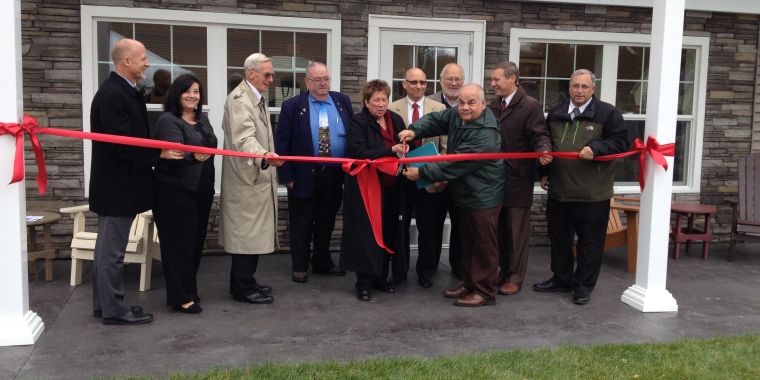
Staid Senator: Now second-in-command in the State Senate, David Valesky vows to remember where he came from

Published May 6, 2009 in the Syracuse New Times
By Ed Griffin-Nolan
There’s always a crowd these days at the offices of New York state Sen. Dave Valesky on the eighth floor of the State Office Building, 333 E. Washington St. On a recent visit a visiting group of union leaders was escorted out before a delegation representing the region’s BOCES staff was led in to meet with the soft-spoken man who not only represents the 49th Senate District but also was recently selected by the Senate Democratic leadership to their second highest post in the upper chamber of the State Legislature. It’s like that, staffers say, every time Valesky is in town.
Valesky, 42, seated in a corner office in front of windows that look north and east from downtown, seems as relaxed as he used to appear on his public television show, Hour CNY, during his days with WCNY-Channel 24. Nothing on the spare white walls or the bare desktop would tell you that the man behind the desk is looked to by many as the voice of upstate in deliberations taking place in the state capitol.
Valesky appears rested in spite of a murderous schedule that has him racing back and forth between Syracuse and Albany each week. His staff struggles to keep him on time through long days in which he is double- and triple-booked.
A Democrat, Valesky, who lives in Oneida with his wife Julie and their three children, Brian, Nathan and Steven, has risen from challenger to being a first-term state senator to being the second most powerful member of the Senate, all within the space of five years. He was elevated to the position of deputy majority leader and vice president pro-tempore on Jan. 8 by Sen. Malcolm Smith of Queens. Smith became majority leader and president pro-tempore after the Democrats took control of the Senate earlier this year for the first time in decades. (The lieutenant governor technically is president of the Senate, but New York has had no lieutenant governor for the past year.) In practice, Valesky presides over the Senate more days than not when it is in session.
Sen. Joe Bruno (R-Brunswick) reigned over the body since 1995 and was a dominant presence in Albany since the Nelson Rockefeller years (1959 to 1973). Since leaving office last year, Bruno has been indicted on federal racketeering charges connected to his outside business interests, an indictment that has caused even greater public skepticism about a legislature famously dubbed the most dysfunctional in the country by New York University’s Brennan Center, and called even worse names by people in the know.
Valesky was never shy about taking on Bruno, whom he referred to during his successful 2006 campaign as “the single greatest hurdle to real reform in the Senate and in Albany.” He won his 2004 race against long-term Democrat-turned-Republican Nancy Larraine Hoffmann for the right to represent the steamshovel-shaped 49th, a district that would warm the heart of Elbridge Gerry, the 19th-century Massachusetts governor for whom gerrymandering was named. The 49th District includes the city of Oneida, pieces of Syracuse and Auburn, the towns of Cicero, DeWitt and Manlius and slices of southern Onondaga, northern Chenango, western Oneida and eastern Cayuga Counties, as well as all of Madison County.
In his new, high-profile role, Valesky has been challenged to put his zeal for reform into action. He serves as co-chair of the Senate’s Temporary Committee on Rules and Administration Reform. On April 24 the committee released its draft report of recommendations to make the Senate’s work more transparent and accessible to the public. In one of his more interesting achievements, Valesky has managed to create a You Tube station for the committee, as a means to solicit broader public input on how the Senate should work. The site can be found at www.youtube.com/watch?v=ipa82-3efQg.
Valesky also sits as an ex-officio member of every Senate committee. While Valesky’s appointment as deputy to Smith has been heralded as evidence that the Senate majority will listen to upstate, his task with the Committee on Reform may prove to be his greatest challenge. Some say he has been asked to do the impossible—to devise ways to take power away from the very man who appointed him.
Can he do it? In spite of his busy schedule, Valesky found time to sit with The New Times to discuss the state of Senate reform and his role in it. The following interview was conducted in his office in mid-March and completed in a telephone follow-up interview May 1.
Q: How do you manage to keep up with sitting on every committee in the Senate?
A: Well, you have to prioritize. We handle it as best as we can. In my role as co-chair of the Temporary Committee on Rules and Administration Reform, we are going to look at how many committees we have in the Senate. There may be some consolidation, and some committees may decrease in size.
The overarching goal is transparency, to make the workings of government more visible to the people. We hope to strengthen the committee process, and to make greater use of the Internet. We held four public hearings—on Long Island, in Syracuse, New York City and Albany—and we now have video from those hearings on our Web site. That in itself is a reform, the fact that all our work at the hearings is on the Web. We have a You Tube station that people can use to comment as well.
Q: In a state that has been living with “temporary” Thruway tolls since the 1960s, we wonder how long will this “temporary” committee be in existence? Will this reform process drag on forever?
A: The committee was charged with issuing a full report by April 13. With the budget going late, that put us back a bit until the 24th. One of our recommendations was to continue the authorization for the committee. I anticipate that they will extend it through 2010, the remainder of this legislative term.
Q: One of the things that the Brennan Report criticized about Albany is the prevalence of “one-house” initiatives: legislation that only sees the light of day in the Assembly or the Senate, but never becomes law. What is being done to make both chambers work together better?
A: I would anticipate that there will be more talks with the Assembly. The Senate can only reform the Senate, and there is plenty we can do there. In my view we should be using conference committees more in the state Legislature. We use them already in the budget process. (Editor’s note: In bicameral legislatures, conference committees are convened to reconcile differences between similar bills passed in the respective houses.)
To the degree that we are successful in the Senate, the Assembly may see our success and adopt similar reforms. Already our committee is talking about a C-SPAN-like channel. We’d like to see all hearings in Albany broadcast so that the public can see them.
Q: In the committee report, you make the recommendation for greater use of conference committees. How does that change things?
A: One recommendation is that we allow the sponsor of a bill or a committee member to call for a conference committee, with the consent of the majority leader. Right now, under the strong leader system, only the majority leader could call for a conference committee.
Q: But you still require the consent of the majority leader. . .
A: Yes.
Q: How does that change the system?
A: It’s a step in the right direction. Heretofore, one senator’s wishes wouldn’t make any difference.
Q: But does it make any difference, if in the end the majority leader has the power to keep the petition from going forward?
A: Maybe it’s a semantics game, but I think this is one step in empowering the individual member. In another section, we recommend that a sponsor be allowed to file a “petition of consideration” with the chair of the committee. With a supermajority you could move a bill out of committee even against the wishes of a committee chair. We have also recommended reducing the number of standing committees by one-third, reducing the maximum number of committees a member can be assigned to, and putting term limits on committee chairs.
Q: Gov. Paterson has said that we are in the greatest economic crisis in generations, and that the state is facing an unprecedented budget shortfall, in the range of $14 billion. In Washington we have President Obama who appears to take the view that the economic crisis is an opportunity to change the relationship between the people and the government. Is there a sense in Albany that the economic downturn can actually help move forward the cause of reform?
A: Yes, I think you can use a crisis to enact reform, but you have to be realistic. We have an immediate constitutional responsibility to pass a budget. This is the greatest budget shortfall in our history, and unlike the federal government we have to balance our budget, we can’t just decide to spend more money. We need to look at trimming spending where we can.
Q: But what about an economy that’s sitting still?
A: This recession will end, and when it does we want to be positioned to go forward. There are real long-term opportunities for us in the federal stimulus plan. The governor just announced a plan for us to compete for as much as $8 billion in federal funds for high-speed light rail connecting upstate along the Thruway corridor and eventually on to New York City. One of my long-term goals is the encouragement of green jobs here in Central New York. We can be a leader in the area of renewable energy, not just on the academic side, but on the economic side.
Q: You once referred to Joe Bruno as “the single greatest obstacle” to reform. Now he’s gone. Now what is the single greatest obstacle?
A: When you try to move reform through a process that has a culture, in this case Albany, that culture isn’t tied to one individual. Changing a culture doesn’t happen overnight: It’s time-consuming. There are already two major changes that we have put in place. One of the first rules we took up has to do with open sponsorship. We changed the rules of the Senate so that any member who wants to sign on can do so without the approval of the Senate leadership, or even the bill’s sponsor.
Q: Why does that matter?
A: This is more than a symbolic change. If I’m working on a bill to benefit Central New York, and Senator John DeFrancisco wants to sign on, he can. It tells the people that their senator can co-sponsor efforts to help them, and can participate fully in a process of change, independent of the Senate leadership.
Q: In the past this was not the case?
A: In the past the leadership could stop you from co-sponsoring. That was one of the things noted in the Brennan Report, that leadership could keep things from coming to the floor and keep senators from co-sponsoring. As we work toward strengthening committees, and diffusing the power in the chamber, we make government more transparent. Another thing we have done in the past four years is reform to member items. Now every project sponsored by every member is posted online so the public knows how their money is being spent. Every organization that has received discretionary funds from the state is now listed at www.sunlightny.com.
Q: We’ve read about huge and uneven expenditures by Senate Republicans during the years they ran the chamber. One report mentioned a television studio they ran in secret that was not made available to the minority party. Now that the Democrats are running the Senate, what’s to prevent them from abusing their power and excluding Republicans?
A: One significant change we have made is that all 62 senators receive a base allocation of $350,000 to run their offices. That is regardless of geography, regardless of party. You’ve read about discrepancies in allocations. This is our way to remedy that.
Q: Is this a permanent change or just an allocation for the current year?
A: Everything in the Senate rules has to be reviewed each time a new senate convenes. Normally the first order of business each time a new senate is elected is to set up and approve its own rules.
Q: So any type of reform like this only remains in effect for two years?
A: This year we approved a set of rules for just one year, so that we will be required to revisit the issue after our temporary committee issues its report.
Q: What has been done to make sure that these changes remain in effect?
A: The change to equal budgeting is not written in stone. But our changes will go a long way toward making sure that any future leaders will not have the power of leaders in the past. The degree to which you empower committee chairs will diffuse the power of Senate leaders. Getting those member items listed as line items in the budget—that makes government more transparent, then the people have the information they need, and they can demand change. It’s hard to imagine them rolling back positive changes.
Q: You have expressed the hope that reform in the Senate will lead to a reduction in partisanship. You made an offer to share some of your member item money with the other senators from Central New York, specifically your Republican colleagues. That offer was not accepted.
A: I thought it was in the interest of their constituents and the region. It’s part of leading by example. It was rejected. The minority has preferred to criticize our report, which I think represents the most important reform effort in a long time. If they were that interested in reform they had 43 years to carry it out.
Q: When you were introduced at Syracuse City Hall by Senator Smith, he said that he would be counting on you to be the voice of those suburbs and farms in upstate New York. Sitting in a large upstate city, which you represent part of, did you find that embarrassing?
A: No. I was asked to represent upstate, and that is from an urban, suburban and rural perspective. We unfortunately have a tendency to define our politics as if there’s an upstate-downstate competition. What Senator Smith articulated is that upstate as a region has distinct needs that need to be addressed, needs that aren’t necessarily in line with those of New York City.
Q: Does the Senate leadership understand that in Central New York we have urban problems?
A: Yes. Absolutely. You can see this from the fact that Senator Smith spent his first full day as Senate majority leader in Syracuse, Rochester and Buffalo. The mayor of Rochester, Robert Duffy, said that he could not recall a time when a Senate majority leader had set foot in Rochester City Hall.
Q: Here’s an example: the Campaign for Fiscal Equity (CFE) lawsuit, which essentially calls for more funding for New York City schools. Does Senator Smith see that as applying to upstate urban school districts as well?
A: Yes, absolutely. The legal requirements of CFE have been satisfied. The fairness and equity parts—on that we still have some way to go. I think that (Syracuse City School District Superintendent) Dan Lowengard will tell you that the funding formula now is more fair than it was. The problem now is the fiscal crisis. But the governor put $350,000 into his budget proposal for Syracuse’s Say Yes to Education program, plus the language to allow for SUNY tuition waivers for Say Yes graduates. That’s a high priority of mine. If we can continue to make the commitment to education here in Syracuse, think of what it will mean for the rest of the state. For me it’s important that the people of the 49th District know that they will always be my priority and first responsibility.
Q: Why does the state Senate still allow its members to work outside jobs? It’s clearly a full-time job, and has a full-time salary ($79,000 plus perks, the third highest in the nation) and a full-time staff.
A: I don’t know all the history, but it goes back to the origins of the state. It’s the way it’s always been, going back to the time when it was a part-time job.
Q: But that time is long gone.
A: I’m not going to criticize any legislator who would have an outside job. I think that what we need to do is to focus on the ethics committee, and moving to a system where we disclose outside areas of income. There have not been serious discussions about going to a full-time Legislature that meets year-round. From a personal perspective I can’t imagine having any time to do anything else. That’s just how I approach my job.
Q: Let’s talk about the budget process. Were you disappointed when it reverted to the old “three men in a room” formula?
A: The budget process moved the way it should through the public hearings, and then in the final weeks it was very frustrating. Leader meetings were not held in public. There were no conference committees, in spite of calls from many of us.
Q: When you were brought in to the leadership, there was the expectation that you would be in the room to, in some sense, represent a voice from upstate. Yet the final budget negotiation was concluded by three men in a room, all of them from New York City. Did you feel a sense of disconnect between the promise and the reality?
A: Not at all. I had direct input on behalf of my constituents on many issues, and my voice was heard. On the gross receipts tax, on dropping the various “fun taxes,” on getting money for SUNY campuses, on countless issues important to upstate.
Q: Did you think reform would take this long?
A: There is always more you can do. You’d always like to do more, but we are making significant progress. It’s important for everyone to realize that reform is an ongoing process. In some ways it never ends.
To read this story online at the Syracuse New Times, click here.


